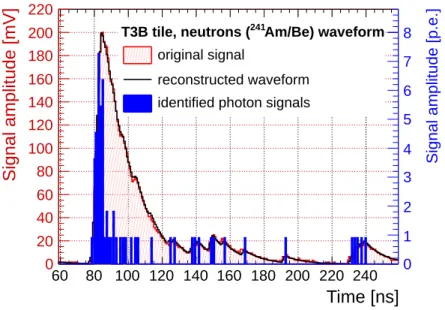T ECHNISCHE U NIVERSIT AT ¨ M ¨ UNCHEN
M AX -P LANCK -I NSTITUT
F UR ¨ P HYSIK
Dissertation in Physics
Top Quark Threshold Scan and Study of Detectors for Highly Granular Hadron Calorimeters at Future Linear Colliders
Michal Tesaˇr
T ECHNISCHE U NIVERSIT AT ¨ M ¨ UNCHEN
M AX -P LANCK -I NSTITUT F UR ¨ P HYSIK
Top Quark Threshold Scan and Study of Detectors for Highly Granular Hadron Calorimeters at Future Linear Colliders
Michal Tesaˇr
Vollst¨andiger Abdruck der von der Fakult¨at f ¨ur Physik der Technischen Universit¨at M ¨unchen zur Erlangung des akademischen Grades eines
Doktors der Naturwissenschaften (Dr. rer. nat.) genehmigten Dissertation.
Vorsitzender: Univ.-Prof. Dr. rer. nat. Martin Beneke Pr ¨ufer der Dissertation: 1. Hon.-Prof. Allen C. Caldwell, Ph. D.
2. Univ.-Prof. Dr. rer. nat. Laura Fabbietti
Die Dissertation wurde am 16.12.2013 bei der Technischen Universit¨at M ¨unchen einge-
reicht und durch die Fakult¨at f ¨ur Physik am 11.3.2014 angenommen.
I assure the single handed composition of this dissertation only supported by declared resources.
Munich, December 16, 2013 Michal Tesaˇr
Abstract
Two major projects for future linear electron-positron colliders, the International Lin- ear Collider (ILC) and the Compact Linear Collider (CLIC), are currently under develop- ment. These projects can be seen as complementary machines to the Large Hadron Collider (LHC) which permit a further progress in high energy physics research. They overlap con- siderably and share the same technological approaches. To meet the ambitious goals of precise measurements, new detector concepts like very finely segmented calorimeters are required.
We study the precision of the top quark mass measurement achievable at CLIC and the ILC. The employed method was a t t ¯ pair production threshold scan. In this technique, simulated measurement points of the t t ¯ production cross section around the threshold are fitted with theoretical curves calculated at next-to-next-to-leading order. Detector effects, the influence of the beam energy spectrum and initial state radiation of the colliding par- ticles are taken into account. Assuming total integrated luminosity of 100 fb − 1 , our results show that the top quark mass in a theoretically well-defined 1S mass scheme can be ex- tracted with a combined statistical and systematic uncertainty of less than 50 MeV.
The other part of this work regards experimental studies of highly granular hadron calorimeter (HCAL) elements. To meet the required high jet energy resolution at the future linear colliders, a large and finely segmented detector is needed. One option is to assemble a sandwich calorimeter out of many low-cost scintillators read out by silicon photomul- tipliers (SiPM). We characterize the areal homogeneity of SiPM response with the help of a highly collimated beam of pulsed visible light. The spatial resolution of the experiment reach the order of 1 µ m and allows to study the active area structures within single SiPM microcells. Several SiPM models are characterized in terms of relative photon detection efficiency and probability crosstalk at the mentioned precision level.
The second experimental study investigates properties of plastic scintillators for an HCAL.
Light collection homogeneity of square scintillator tiles with an area of a few cm 2 and a
few mm in thickness is probed with a collimated electron beam from a radioactive 90 Sr
source. The same experimental apparatus is used to quantify the light crosstalk between
two neighboring scintillator cells. Two tile designs are tested and a high degree of homo-
geneity and low crosstalk level is demonstrated for one of the samples. Additionally, the
sensitivity of the scintillators to neutrons is tested by irradiating the tiles with a 241 Am/Be
neutron source. A substantial neutron sensitivity even with spectroscopic capabilities is
observed. This measurement is compared with Monte Carlo simulation. A good agree-
ment is demonstrated. It confirms that the experiment can be realistically described by
taking into account only basic physical processes.
CONTENTS
Preface 1
I. Introduction and Motivation 5
1. Standard Model of Particle Physics 7
1.1. Introduction . . . . 7
1.2. Higgs Mechanism . . . . 9
1.3. Shortcomings of the Standard Model . . . . 10
1.3.1. Supersymmetry . . . . 11
1.4. The Top Quark . . . . 12
1.4.1. Role of the Top Quark in the Standard Model . . . . 12
1.4.2. Mass Definitions . . . . 13
1.4.3. Mass Measurement Methods . . . . 14
2. Future Linear Colliders 15 2.1. Motivation for a Linear e + e − Collider . . . . 15
2.2. Physics Potential . . . . 17
2.3. Accelerator Concepts . . . . 19
2.3.1. Compact Linear Collider . . . . 19
2.3.2. International Linear Collider . . . . 20
2.4. Detector Systems . . . . 22
2.4.1. International Large Detector . . . . 22
2.4.2. Silicon Detector . . . . 25
2.5. Detector Requirements . . . . 25
2.5.1. Particle Flow . . . . 26
2.5.2. Timing Requirements at CLIC . . . . 27
3. Silicon Photomultipliers 29 3.1. Basic Layout and Working Principle . . . . 29
ix
Contents
3.1.1. Quench Resistor . . . . 31
3.2. Gain . . . . 33
3.3. Photon Detection Efficiency . . . . 34
3.4. Signal Response Function and Saturation . . . . 35
3.5. Dark Noise and Afterpulsing . . . . 36
3.6. Optical Crosstalk . . . . 37
3.7. Temperature Effects and Light Intensity Measurement . . . . 38
II. Technology for Future Linear Colliders 39 4. Silicon Photomultiplier Homogeneity Studies 41 4.1. Photon-Emission Measurement . . . . 42
4.2. Experimental Apparatus . . . . 43
4.3. Data Analysis . . . . 46
4.3.1. Measurement Data . . . . 46
4.3.2. Coincidence Distribution and Noise Subtraction . . . . 47
4.3.3. Crosstalk and Pure 1 p.e. Maps . . . . 48
4.3.4. Analysis of Single Pixels . . . . 49
4.4. Results . . . . 52
4.4.1. Hamamatsu Multi-Pixel Photon Counters . . . . 52
4.4.2. Silicon Multi-Pixel Light Sensors . . . . 56
4.4.3. MEPhI and SensL Devices . . . . 60
4.5. Summary . . . . 61
5. Scintillator Tile Studies 63 5.1. Detector Layout . . . . 64
5.1.1. Scintillator . . . . 64
5.1.2. Silicon Photomultiplier . . . . 65
5.1.3. Light coupling . . . . 66
5.2. Readout System . . . . 68
5.3. Tests with β -Source . . . . 69
5.3.1. Experimental Apparatus . . . . 69
5.3.2. β -Source Properties . . . . 71
5.3.3. Trigger Configuration . . . . 72
5.4. Neutron Irradiation . . . . 74
5.4.1. Experimental Apparatus . . . . 75
5.4.2. Neutron Source Properties . . . . 75
5.4.3. Trigger Configuration . . . . 76
5.5. Data Analysis Tools . . . . 78
5.5.1. Experimental data . . . . 78
5.5.2. First Stage: Data Calibration . . . . 79
5.5.3. Second Stage: Calibrated Data Analysis . . . . 80
5.6. Results . . . . 83
5.6.1. Two-Dimensional Tile Scans . . . . 83
5.6.2. Crosstalk Scans . . . . 86
x
Contents
5.6.3. Neutron Irradiation . . . . 89
5.7. Summary . . . . 93
III. Precise Top Quark Mass Measurement at Future Linear Colliders 95 6. Precise Top Quark Mass Measurement at Future Linear Colliders 97 6.1. Top Quark Identification and Reconstruction . . . . 98
6.1.1. Key Physical Processes and Event Generation . . . . 98
6.1.2. Top Quark Reconstruction . . . 100
6.2. Top Quark Threshold Scan Simulation . . . 102
6.2.1. Calculation of the t t ¯ Production Cross Sections . . . 103
6.2.2. Corrections of the Cross Section . . . 104
6.2.3. Simulation of Data Points . . . 107
6.2.4. Template Fit . . . 109
6.3. Results . . . 114
6.3.1. Influence of Simulation Input Parameters . . . 114
6.3.2. Single m t Fit . . . 116
6.3.3. Simultaneous m t and α s Fit . . . 118
6.4. Top Quark Pole Mass . . . 121
6.5. Summary . . . 122
Conclusions 125 Acknowledgements 129 Appendix 133 A. Lists of Used Experimental Equipment 133 B. Silicon Photomultiplier Measurement Summary 137 B.1. Relative PDE and Crosstalk Maps . . . 137
B.2. Single Pixel Analysis Plots and Coincidence Distributions . . . 152
B.3. Photo-Emission Images Overlaid with SiPM Photographs . . . 160
B.4. Photographs of SiPM . . . 162
C. Top Quark Mass Measurement Summary 165 C.1. Two-Dimensional Template Fit Contour Plots . . . 165
C.2. Complete Result Summary of One-Dimensional Template Fit . . . 166
C.3. Complete Result Summary of Two-Dimensional m t and α s Template Fit . . . 169
Bibliography 175
List of Figures 183
List of Tables 187
xi
PREFACE
The subject of particle physics is to study, understand and mathematically describe matter at subatomic scales. This comprises investigations of radiation, elements of matter itself and interactions between these constituents. A theoretical framework of particle physics was gradually developed, confronted with experimental reality and extended. A global scientific effort resulted in the second half of the 20th century in an extraordinarily suc- cessful theory called the Standard Model of particles physics. The last few decades of experimental research up to the present day are dedicated to confirm or disprove predic- tions and calculations based on the Standard Model. In spite of all the success of the theory, there are some inconsistencies with the observed physical reality. This leads to a further urge for theoretical extensions on one hand and experimental guidance by discoveries on the other hand. Highly precise measurements are one of the aims of particle accelerator ex- periments. A contemporary particle accelerator which is providing the most accurate data so far is the Large Hadron Collider (LHC) at CERN. Despite its great performance and the recent success of discovering a new particle which is likely the Higgs boson, a lepton col- lider experiment is in general capable of achieving an even better precision. A construction of a new lepton collider together with continual improvements of experimental methods and technology can contribute a lot to deepen our understanding of this material world.
There are two major future e + e − accelerator projects which are meant to be complemen- tary machines to the LHC. These are the International Linear Collider (ILC) and the Com- pact Linear Collider (CLIC). Even though there are some significant differences between the two, many parts of the projects overlap and share the same technological approaches.
The goal of this thesis is to contribute to the ongoing research and development effort which will at the end results in a high-performance particle accelerator experiment. There are many aspects of such a project which have to be studied and prepared. In this work, we address two different topics with one common underlying connection.
Top quark physics is one of the important field of study at the LHC and also at future linear colliders (FLC). We present a simulation-based study of the FLC capability to per- form precise measurements of the top quark mass. We determine the mass by using a threshold scan. It is based on the measurement of the t ¯ t pair production cross section in e + e − collisions in the vicinity of the threshold. The top mass itself was obtained from a
1
Preface
template fit of the cross section data. The study included also further unwanted physics and detector effects on the measurement. Statistical and systematic uncertainties of the top 1S mass determination at CLIC and the ILC were calculated and represent together the total uncertainty of the measurement. The strong coupling constant was also extracted by the template fit and its precision is presented as well.
A high jet energy resolution of a collider experiment is a crucial parameter for reaching a satisfactory top quark identification efficiency. To meet the desired precision, a completely new hadron calorimeter concept is required. A new technological approach needs also development on the hardware level. Characterization of elements of prototype hadron calorimeter units is the second topic presented in this thesis. An FLC will employ highly granular hadron sandwich calorimeters. One option for the active calorimeter part are plastic scintillators. In this case, a single cell must have a volume of just a few cm 3 . To maintain compactness of the detector, usage of photomultiplier tubes is excluded. They must be replaced by much smaller silicon photomultipliers (SiPM). The areal homogene- ity of SiPMs response was investigated in the first part of the technical studies. The ho- mogeneity was probed by a highly collimated pulsed visible light beam. The spatial res- olution of the experiment allowed to observe active area structures within single SiPM microcells. Hamamatsu Multi-Pixel Photon Counters (MPPC) were the main subject of interest.
The second studied element of the calorimeter units were the scintillators. The plastic scintillators in the calorimeter are square-shaped tiles and the scintillation light is read out from one side by a SiPM. Areal light collection homogeneity of the scintillator tiles was investigated with a collimated electron beam from a radioactive source. This method al- lows to characterize and compare different tile designs. Additionally, the sensitivity of the scintillator to neutrons was tested by irradiation of the tiles with a radionuclide neu- tron source. Our study was motivated by differences observed by the Tungsten Timing Test-Beam experiment experiment in the response of a calorimeter with steel and tungsten absorbers. This points to the importance of understanding neutron detection in hadron calorimeters.
This thesis is divided into three parts which logically separate the theoretical and in- troductory, experimental, and physics-simulation dedicated chapters. First, we give an overview of the Standard Model. The symmetry concepts of the theory and the Higgs mechanism are explained. Some shortcomings of the construction which are leading the scientists to introduce further extension like the Supersymmetry and which are putting completeness of the Standard Model into question are also addressed in chapter 1.
Chapter 2 gives an introduction to the topic of future linear colliders. It mentions the physics motivation of a new accelerator experiment as well as technical aspects of the machine. Possible choices of accelerating technology for the colliders are discussed. We also summarize the important parameters of the detector systems.
Information about the basic properties of silicon photomultipliers is given in chapter 3.
The details of SiPM construction and operation are explained. Further, we present different options of quench resistor implementation. Impacts of operating conditions of the sensor and possible performance deterioration are described.
In chapter 4, we present the study of SiPMs. The areal response homogeneity of several
2
Preface
SiPM types was investigated with the main emphasis on Hamamatsu MPPCs. The techni- cal aspects of the experimental apparatus and measurement data analysis are described in detail. Finally, the results are discussed. The complete results of SiPM measurements are summarized in appendix B.
The characterization studies of plastic scintillators are presented in chapter 4. Technical details of used experimental setups are given as well as a description of the analysis tech- niques. The characteristics and performance of two different scintillator tile materials and designs are compared and discussed. The experimental results of the neutron irradiation are also confronted with a Monte Carlo simulation.
In chapter 6, the simulation of the top quark threshold scan at CLIC and the ILC is presented. The data simulation and analysis process is described in detail. Several sources of systematic uncertainties like ambiguities in background level, strong coupling constant and theoretical cross section calculation are addressed. The simulation was performed for the top pole and 1S mass scheme with the focus on results for the 1S mass definition. The full summary of top mass measurement simulation results is shown in appendix C.
Lists of experimental equipment with some technical details are summarized in ap- pendix A.
Parts of this thesis were already published in references [1] and [2].
3
Part I.
Introduction and Motivation
CHAPTER 1
STANDARD MODEL OF PARTICLE PHYSICS
The Standard Model of particle physics (SM) is the central theory of particles of the present day. It is a quantum field theory which describes all known elementary particles and three of the four known fundamental physical forces of the nature: the strong, the weak and the electromagnetic. The contemporary form of the SM has been established in the 70’s of the 20th century. Since then, it has had major success in describing experimentally observed phenomena and predicting existence of further particles. The past predictions of particles were based on symmetry considerations. The ν τ , the b, c and t quarks and the W and Z bosons were forecast this way and experimentally discovered later on. In the year 2012, another outstanding breakthrough has been achieved by the Large Hadron Collider (LHC) at the European Organization for Nuclear Research (CERN 1 ) when the ATLAS [3] and the CMS [4] collaborations announced the discovery of a boson compatible with the Standard Model Higgs boson [5, 6] which is also predicted. However, the SM has some issues. For example, it cannot predict masses of elementary particles from first principles, it does not include gravity and it cannot explain dark matter and dark energy which form 95 % of
“visible” universe. The Standard Model and its shortcomings will be discussed in this chapter.
1.1. Introduction
The SM is mathematically described by a scalar Lagrange density function (shortly La- grangian). It is generally based on Yang-Mills Theory [7, 8] which requires invariance of the Lagrangian under local gauge transformations (up to constant terms). These transfor- mations are in this case given by a representation of a special unitary gauge group SU(n) of degree n N and have a general form
1
![Figure 1.2.: Example of the Higgs potential in one dimension. Taken from [18].](https://thumb-eu.123doks.com/thumbv2/1library_info/4015706.1541392/22.892.224.619.154.456/figure-example-higgs-potential-dimension-taken.webp)
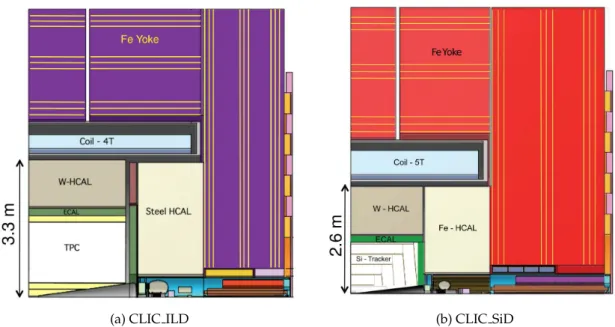
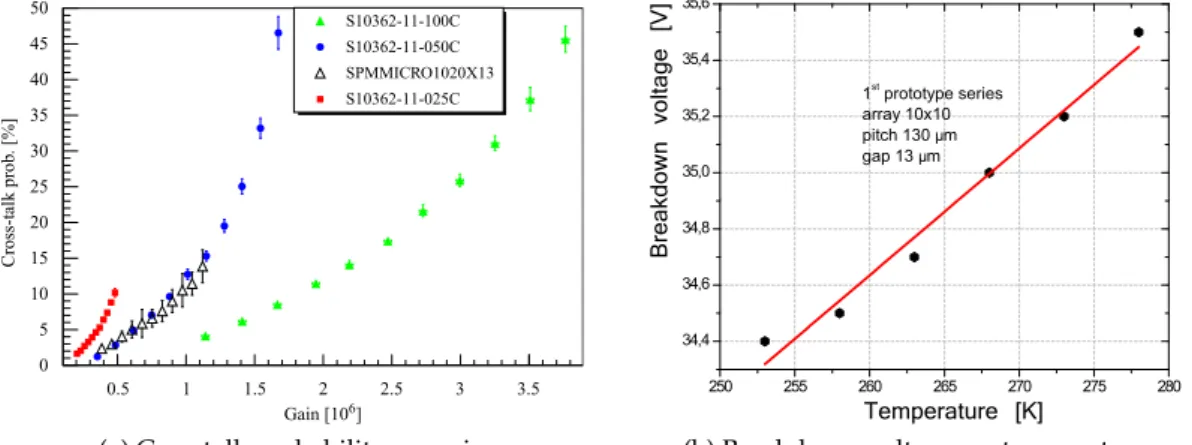
![Figure 4.2.: Simplified SiPM scan setup schematic. The complete scheme can be found in [80].](https://thumb-eu.123doks.com/thumbv2/1library_info/4015706.1541392/56.892.99.743.146.479/figure-simplified-sipm-scan-setup-schematic-complete-scheme.webp)
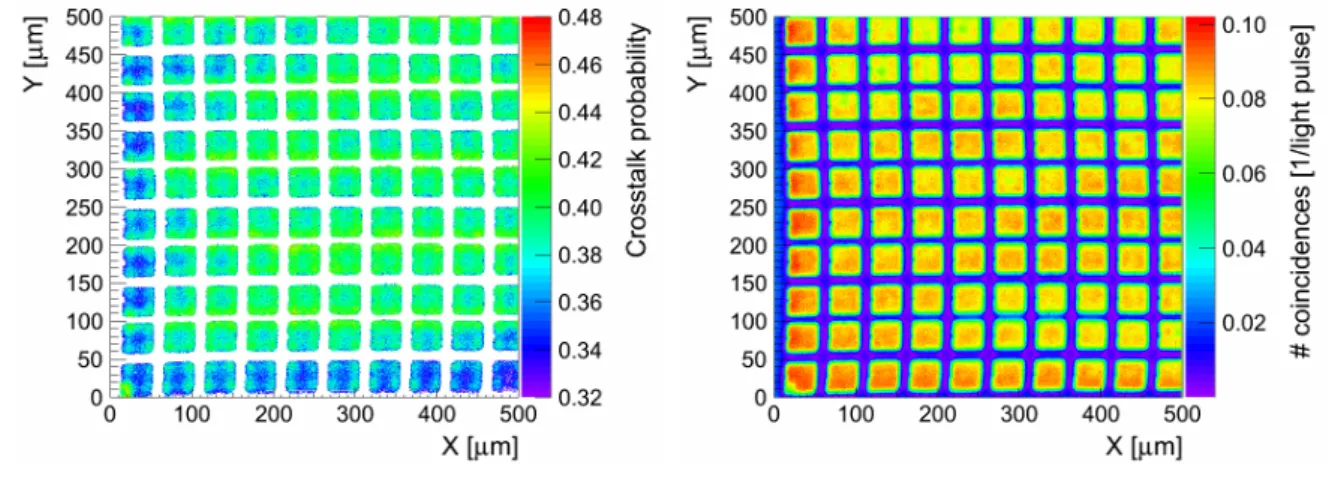
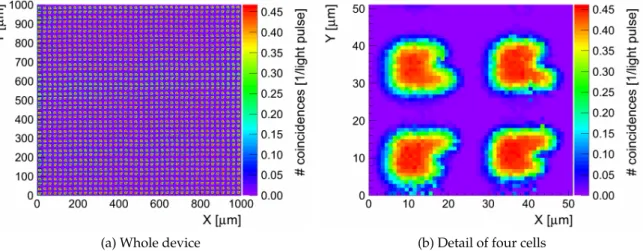
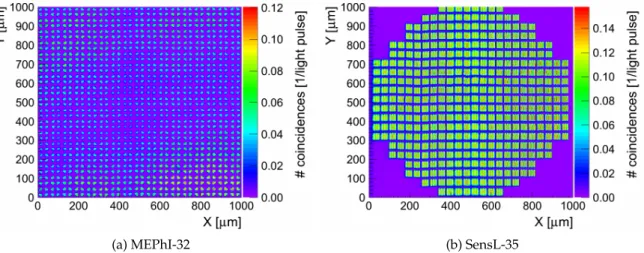
![Figure 5.8.: Electron energy spectrum of 90 Sr/ 90 Y source calculated based on Fermi’s the- the-ory of beta decay [97]](https://thumb-eu.123doks.com/thumbv2/1library_info/4015706.1541392/85.892.273.635.168.422/figure-electron-energy-spectrum-source-calculated-based-fermi.webp)
